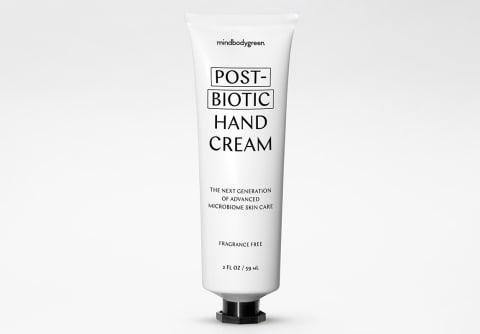Advertisement
Dry, Cracked Hands? Why It Happens + 5 Ways To Keep Your Paws Supple


When your skin is dry, your hands are one of the first areas to betray that lack of moisture. No, seriously: When it comes to triggers that contribute to dry skin, your paws often take the first offense. You use your hands quite a bit from day to day—and this frequent wear and tear can leave them rough and cracked. There are admittedly some optics at play, too: Because you use your hands so frequently, you may notice a scaly appearance more than other easily covered-up areas.
Dry hands are also irritating—in more ways than one. Yes, the chapped skin can be uncomfortable, itchy, and sometimes painful, but it's also annoying to deal with, considering how much we use our hands on the regular.
So we'll get right to it: If you're wondering how to save your raw, dry hands, here's how to keep them supple.
What causes dry hands?
The root of your scaly, cracked hands? Well, there could be a couple of culprits:
Aging
You've likely heard it once or twice before: As you grow older, your skin loses structural components (collagen, elastin, hyaluronic acid, etc.) that keep it supple and strong. When these components break down, your skin barrier function suffers—and a weak barrier doesn't hold in water as well (a concept known as transdermal water loss). Alas, your skin becomes drier.
Your body's natural oil production also decreases1 as you age, which can result in cracks and fine lines. It's why derms often tout the importance of moisture and a good, thick occlusive to keep the skin hydrated.
Weather
On the topic of transepidermal water loss, did you know it happens more during the winter? Cold, dry, arid weather can weaken your skin barrier function, especially if you oscillate between the frigid outdoors and the cozy, indoor heat. And so we repeat: When your barrier weakens, it's easier for water to seep out, which can cause dryness, flaking, and discomfort.
Hand-washing woes
Hand hygiene is a must, full stop. But how you scrub can make a world of difference for your skin microbiome. See, when you wash your hands consistently without replenishing that moisture, blast your microbiome with alcohol-based sanitizers, or run your skin under scalding water, your skin barrier tends to pay the price.
On that last note, "Hot water evaporates faster," board-certified dermatologist Purvisha Patel, M.D., founder of Visha Skincare, told us about the ideal water temperature. Not to mention, hot water also has the ability to strip the natural oils and lipids from your skin; and when your lipid barrier is continuously compromised, cracks and scaly, itchy skin tend to follow suit.
Harsh soaps and sanitizers
Speaking of hand-washing etiquette, the products you use can also weaken your skin barrier and lead to dry, uncomfortable skin. In terms of soaps, common culprits like sulfates and fragrance can aggravate the skin, causing dryness and irritation.
As for alcohol-based hand sanitizers, these don't just kill the bad bacteria: They kill the good, necessary guys, too. "These types of alcohols do major damage to the natural lipids and fatty acids on the surface of your skin, so they damage your skin barrier," board-certified dermatologist Whitney Bowe, M.D., says regarding sanitizers. We're not saying you should always skip the sanitizer (again, hand hygiene is a must, and when you're on the go, sanitizer may be your only option!), but it's important to be diligent about aftercare if you do go that route.
Eczema
"Hand eczema, or hand dermatitis, is characterized by redness, blistering, cracking, flaking, and itching of the palms and fingers," board-certified dermatologist Hadley King, M.D., tells us about the condition. It's a common area to experience flare-ups if you have eczema, as your hands come into contact with a bunch of environmental triggers (including contact allergens, like sanitizers and detergents); so if you're genetically predisposed to the condition, your hands may be quick to crack and dry.
How to relieve it.
To restore your hands back to supple and soft, we recommend the below:
Moisturize.
Moisturize, moisturize, moisturize. We cannot recommend it enough: "It's essential to moisturize as often as possible to restore those lipids and encourage the regrowth of healthy bacteria, or your microbiome," Bowe says. It's especially important after washing your hands or taking a shower: A good cream can seal in that lingering water, restore your skin's lipids, and prevent transepidermal water loss2.
That said, grab a butter-thick occlusive and slather it on whenever your paws need a hit of moisture. And for those wondering: Yes, you can find a dense cream that doesn't make your hands too greasy. A mix of hydrators and rich butters (think aloe vera paired with shea butter) can keep a cream fast-absorbing while locking in moisture.
Bonus points if your cream contains soothing ingredients known for their anti-inflammatory properties (oat comes to mind), as dry, cracked hands can quickly feel uncomfortable and itchy. See here for our favorite hand creams for dry skin.
Practice good hand-washing hygiene.
Yes, you should still wash your hands. Just find yourself a soothing, hydrating hand soap, stick to a room-temperature rinse, and apply moisturizer immediately after toweling off (Bowe recommends waiting no longer than two minutes). You may also want to favor hand soaps over sanitizer whenever you can, as the large concentrations of ethanol and isopropanol are a bit harsher on the skin, even coupled with conditioning agents like aloe.
Use hydrating soaps.
"Ideal soaps are made without harsh sulfates like sodium lauryl sulfate, that can damage the skin barrier," Bowe tells us. "I also love seeing hand soaps that are enriched with soothing, hydrating ingredients like milk, aloe, honey, and oatmeal. Also, any ingredients that restore the barrier and help bring the pH back to the normal range—slightly acidic—are imperative. Our skin has an invisible layer called the 'acid mantle,' and we need to respect the pH of our skin to keep it healthy." (See here for our favorite, non-stripping soaps for dry skin.)
Protect with gloves.
As we mentioned, your hands come into contact with a bunch of potential irritants. Even humdrum, household tasks (like washing dishes or scrubbing counters) can cause cracked and scaly hands, which is why many experts recommend you invest in a pair of gloves to wear during labor or housework. By keeping the skin protected from those drying allergens, you can help alleviate some of the discomfort.
You can even take it a step further and slather your hands in a nourishing oil or moisturizer before pulling on the dishwashing gloves: The oil will infuse your skin with softening lipids and antioxidants, and the steamy, sudsy water increases the skin's permeability3, which can help these ingredients penetrate deeper into the pores for baby-soft skin.
See a derm.
If the discomfort is bordering on painful or severe (say, if you notice intense scaling or bleeding), it's best to see a professional who can find targeted treatments for any potential infections. Oftentimes, dry hands are nothing to sound the alarm over—but it's always a good idea to consult your derm if you're at all concerned.
The takeaway.
The cause of dry hands is a tough nut to crack, considering all the factors (environmental, lifestyle, and genetic) that can contribute to a scaly appearance. No matter: With these steps, you can alleviate some of the discomfort and keep your paws baby-smooth.
Watch Next
Enjoy some of our favorite clips from classes
Enjoy some of our favorite clips from classes
What Is Meditation?
Mindfulness/Spirituality | Light Watkins
Box Breathing
Mindfulness/Spirituality | Gwen Dittmar
What Breathwork Can Address
Mindfulness/Spirituality | Gwen Dittmar
The 8 Limbs of Yoga - What is Asana?
Yoga | Caley Alyssa
Two Standing Postures to Open Up Tight Hips
Yoga | Caley Alyssa
How Plants Can Optimize Athletic Performance
Nutrition | Rich Roll
What to Eat Before a Workout
Nutrition | Rich Roll
How Ayurveda Helps Us Navigate Modern Life
Nutrition | Sahara Rose
Messages About Love & Relationships
Love & Relationships | Esther Perel
Love Languages
Love & Relationships | Esther Perel


















